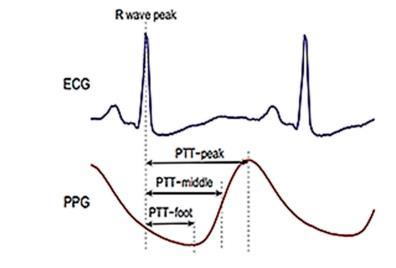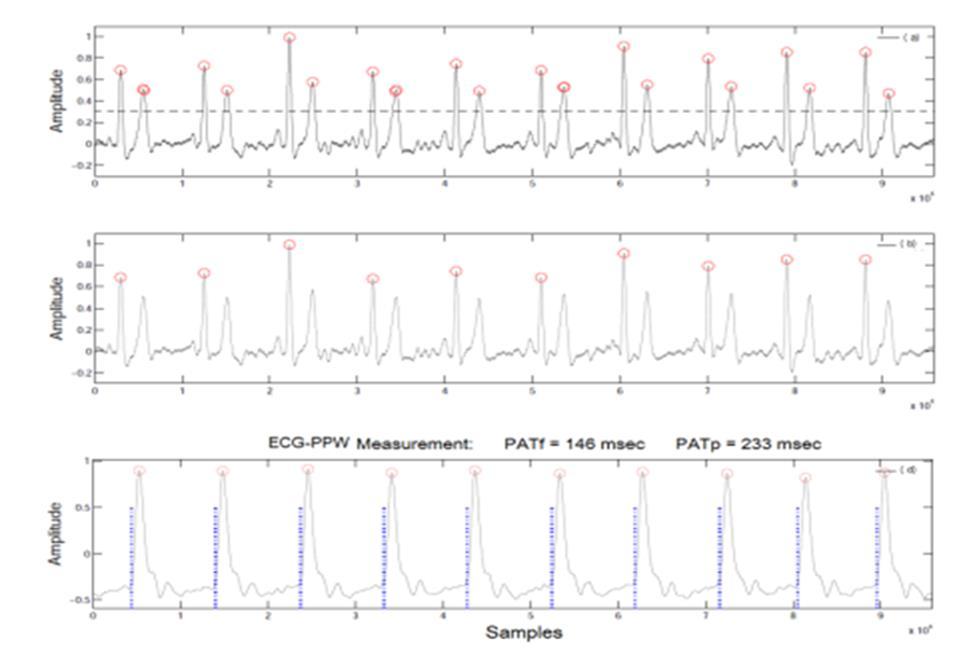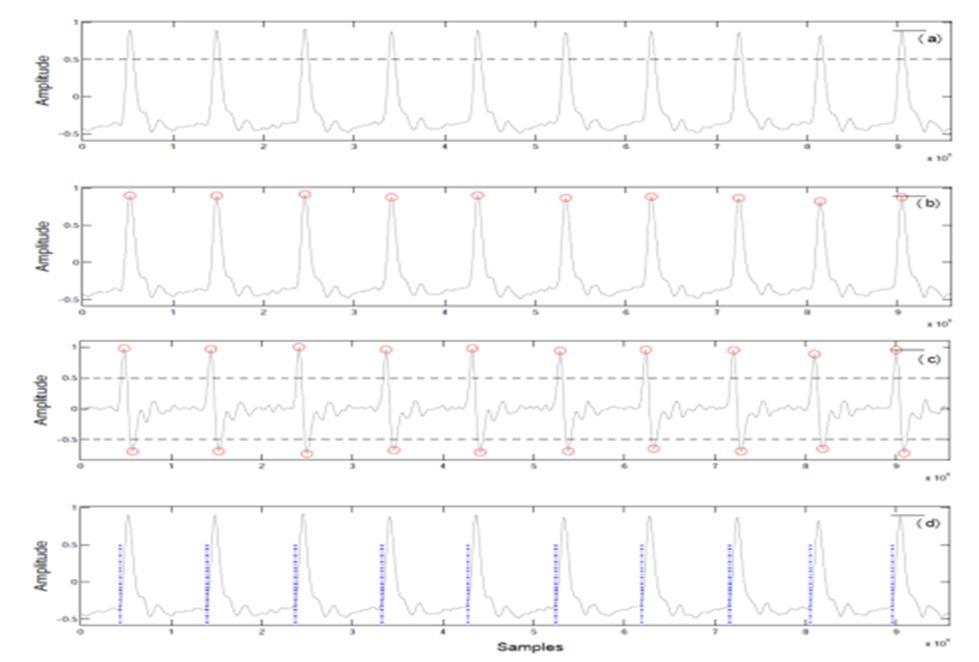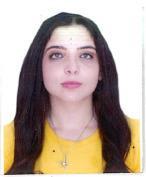A NEW LOW-COMPLEXITY ALGORITHM FOR THE PULSE TRANSIT TIME EVALUATION
Radjef Lilia and Omari TaharDepartment of Electrical Engineering Systems,
ABSTRACT
University, Boumerdes, Algeria
BoumerdesThe pulse transit time (PTT) is a physiological parameter commonly derived from Electrocardiogram (ECG) and Photoplethysmogram (PPG) signal. It is defined as the time taken for the arterial pulse to travel from the heart to a peripheral site, and can be used as a direct indicator of Cardiovascular Diseases (CVD) In this study, we propose a new low-complexity algorithm for the (PTT) estimation The (PTT) is calculated as the interval between the peak of the ECG R-wave and a time point on the PPG. We considered a dataset of 37 subjects containing a simultaneous recording of the (ECG) and the (PPG). The computation of the (PTT) consists of detecting the peak and foot points of a (PPG) and the R peak of the (ECG) signal. Our algorithm is improved by a temporal analysis by windowing. The results obtained are promising. The average sensitivity (SEN) and accuracy (ACC) obtained are respectively (97.5%, and 96.82%) for the detection of R peaks and (97.77%, and 97.64%) for the detection of PPG peaks. The sensitivity (SEN) and accuracy (ACC) of the foot (PPG) detection were 98.33% and 94.14%.
KEYWORDS
Pulse transit time (PTT), Cardiovascular Disease (CVD), Electrocardiogram (ECG), Photoplethysmography (PPG), Algorithm, Peaks detection, Sensitivity (SEN), Accuracy (ACC).
1. INTRODUCTION
Cardiovascular disease is the leading cause of death in the world, according to the World Health Organization (WHO). The early detection of vascular diseases can be the key to effective prevention and treatment [1, 2, 3]. Pulse transit time (PTT) provides information from the arterial tree on arterial stiffness (AS) [4], vessel compliance, and blood pressure (BP) [5, 6, 7, 8]. The pulse transit time (PTT) is defined as the time taken for the pulse wave to travel from a proximal point to a distal point in the arterial system. It is based on the Moens-Koertweg and BramwellHill equations [9] and is inversely related to the pulse wave velocity (PWV), which is calculated as the distance traveled by the pulse wave divided by time. The use of (PTT) dates back to 1964 when Weltman et al [10] designed the PWV computer based on the use of the (ECG) complex and a downstream pulse signal to determine the pulse transit time over a known arterial length. The (PTT) can be measured using pulse wave transducers placed close together in a homogeneous arterial segment [11] (as shown in Figure 1).
There are different non-invasive techniques to measure (PTT), such as arterial tonometry, doppler ultrasound, electrocardiography (ECG signal represents the electrical activity of the heart)photoplethysmography (PPG signal measures changes in blood volume), and pressure transducers [12, 13, 14,15,16]. The (PTT) techniques are reproducible, non-invasive, easy, and safe, it is therefore not necessary for specialized training required for medical staff to handle them. Depending on the equipment used and the applications, the (PTT) can be defined as the time difference between the onset of cardiac ejection approximated by the R-peak in the electrocardiogram (ECG) and the arrival of the pulse at the fingertip as determined by the photoplethysmogram (PPG) [17, 18, 19, 20, 21, 22] (shown in Figure 2). Promising applications of (PTT) include the detection of stroke and myocardial infarction [23], sleep-disordered breathing [24], monitoring of ductus arteriosus closure in neonates [25], detection of sympathetic nervous system (SNS) excitation [26], etc. The evolution of (PTT) is related to changes in the cardiovascular system. For example, changes in systolic blood pressure (SBP) and/or arterial stiffness (AS) [27].
A combination of the (ECG) and (PPG) signals leads to the measurement of another cardiovascular parameter called pulse arrival time (PAT). The (PAT) includes not only the desired (PTT) but also a rejection period (PEP). This approach has been extensively reported in the literature [28, 29, 30] Another approach (2), the (PTT) can be acquired by observing two (PPG) waves distant from each other [31,32], or by using only one (PPG) signal [33, 34, 35, 36], different measurement sites exist in the periphery including the finger, ear lobe, toe, and forehead although they are less practical. To measure the (PTT) (or PAT), various vital signals such as Photoplethysmograph (PPG), electrocardiogram (ECG), ballistocardiogram (BCG),


Bioscience & Engineering: An International Journal (BIOEJ), April 2023, Volume 10, Number 1/2
gyrocardiography (GCG), impedance plethysmography (IPG), electrical bio-impedance (Bimp), the PPG/tonoarteriogram (TAG), impedance cardiography (ICG) and seismocardiogram (SCG) can be used [37]. The features obtained from the (ECG) and (PPG) signals depend on the purpose or type of disease and diagnosis to be estimated. In the literature, several algorithms based on characteristics of the pulse waveform analysis have been proposed, mainly focusing on the determination of the characteristic point’s peak detection [38, 39, 40, 41], and located at the foot of the wave. The robust determination of characteristic points is still a difficult task in the (PTT) estimation due to motion artifacts, electrical interference noises, and signal crossovers among others, and also due to respiration This article presents a new algorithm for non-invasive measurements of pulse transit time (PTT), obtained by measuring the pulse time between the heart and the finger. The (PTT-Peak) and (PTT-Foot) are the time delays between the peak of the wave (ECG-R) and the peak and foot (PPG), respectively.
2. METHODOLOGY
The (ECG) and (PPG) signals were processed to measure the (PTT), which is estimated using the algorithm illustrated in Figure 3. The (PTT-foot and PTT-peak) values are obtained by the measurement of the differences between the (PPG) (foot, peak) locations and R-peak locations.
2.1. Training Dataset
First, we constructed a data set of 37 subjects containing a simultaneous recording of (ECG) and (PPG). All subjects signed a voluntary participation agreement for this study. Approval for data acquisition was granted by the ethics committee of the University of Tlemcen.
2.2. The PTT Algorithm
First, the (PPG) is normalized at the value of 1 according to the equation (1):
P P G (normalized) = (P P G .(n)/ (max (P P G)) (1)
Where n: is the normalization factor. In our case, it equals 1.
The peaks (PPG) were detected using a thresholding operation (a threshold of 0.5). To detect local maxima and minima, the first derivative was calculated and thresholded symmetrically (+0.5 and -0.5). Subtracting each peak location (in the PPG signal) with the difference between its minima and maxima location (in the derivative signal) perfectly detects the (PPG-foot). The (PPG-foot) detection process evolved mathematically from a Gaussian pulse (which strongly corresponds to a (PPG) pulse) and its first derivative, all steps (shown in Figure 4). Signal processing (ECG) begins with normalization (to the value of 1) followed by a thresholding operation (to the value of 0.3) to detect peaks R. A threshold value is set to less than 1% of the pulse value. The threshold value is set to less than 50% of the normalized signal to avoid any loss in detection, as well as to avoid misleading detection of R-peaks resulting in some cases from large amplitude T-waves. The algorithm is improved by a temporal analysis by windowing, from which the maximum value in each window perfectly locates the R peak, (as shown in Figure 5).
Bioscience & Engineering: An International Journal (BIOEJ), April 2023, Volume 10, Number 1/2
Recording the (ECG) and (PPG) signals or (ECG) and (PPG) Database
Raw(PPG) Raw(ECG)
Normalization Normalization
Segments containing both waveforms simultaneously
Features extraction
ECG PPG
Thresholding Operation Thresholding Operation
R-PeakDetection
Outlier Removal
Improvement of RPeakDetection
ECG-Peak
PPG-PeakDetection
PPG-Peak
PTT- Peak R-Peak-PPG-Peak
First Derivative Positive Thresholding Positive Thresholding Maxs Detection Mins Detection
Diff= Max-Min
PTT- foot R-Peak-PPG-foot
Location of Pulse foot PPG-foot = Peak-Diff
3. RESULTS
Figure 4. Localization result of (PPG-foot) and (PPG-peak). (a): normalization and thresholding operation, (b): (PPG-Peak) detection, (c): the first derivation of (PPG) signal and detection of local maxima and minima, and (d): (PPG-foot) localization
Figure 5. (ECG) processing and measurement of (PTT) foot and peak, (a): normalization, thresholding operation, and all local maxima detection, (b): improvement of R-peak detection, (c): measurement of (PTT-foot), and (PTT-peak)


4. DISCUSSION
Experimental results of the proposed algorithm are evaluated in terms of sensitivity (SEN) and accuracy (ACC) given by equations (2) and (3), respectively. Where TP (true positive) is the number of peaks (or feet) correctly recognized, FN (false negative) is the number of peaks (or feet) missed, and FP (false positive) is the number of false peaks (or feet) recognized as true.
SEN = T P/(T P + F N) ×100% (2)
ACC = T P/(T P + F N + F P) ×100% (3)
Where TP (true positive) is the number of peaks (or feet) correctly recognized, FN (false negative) is the number of peaks (or feet) missed, and FP (false positive) is the number of false peaks (or feet) recognized as true. Obtained results show satisfactory performances on the records. We note that only the correct detections are used in this study.
Table 1 shows the accuracy and sensitivity values of the algorithm. The total beats recorded over all subjects were 719 beats with an average of 24±9 beats. In the case of R-peak detection (ECGp), the algorithm fails to detect 23 beats (18 FN beats and 5 FP beats) out of 719 beats. The average SEN and ACC of R peaks detection were 97.5%, and 96.82% respectively. In the case of PPG-peak detection, the algorithm fails to detect 17 beats (16 FN beats and 1 FP beat) out of 719 beats. The average (SEN) and (ACC) of PPG-peak detection were 97.77%, and 97.64%, respectively. In the case of PPG foot detection, the algorithm mislocated 54 beats (12 FN beats and 32 FP beats) out of 719 beats. The average (SEN) and (ACC) of (PPG- foot) detection were 98.33%, and 94.14%, respectively.
Table 1. Detection results of the algorithm.
Total beats=719(Avg=24±9 beats)
5. CONCLUSIONS
In this paper, a new algorithm for the estimation of (PTT) was introduced. The (PTT) is a parameter of major importance in the prevention of cardiovascular diseases, especially arterial aging and hypertension. For the estimation of (PTT), the collected data were processed. Using the (ECG) and (PPG) signals, we obtained the (PTT- foot) and (PTT- peak). A good result was found by evaluating several statistical measures.
REFERENCES
[1] J. Stamler, R. Stamler, JD. Neaton. Blood pressure, systolic and diastolic, and cardiovascular risks. US population data. Arch Intern Med 1993; 153:598–615.
[2] J. He, PK. Whelton. Elevated systolic blood pressure and risk of cardiovascular and renal disease: an overview of evidence from observational epidemiologic studies and randomized controlled trials. Am Heart J 1999; 138 (3 Pt 2):211–219.
[3] World Health Organization, World health statistics 2019: Monitoring health for the SDGs sustainable development. Goals. World Health Organization, 2019, vol. 3,no.2.https://apps.who.int/iris/handle/10665/324835.
[4] S. Laurent, J. Cockcroft, LV. Bortel, P. Boutouyrie, C. Giannattasio, D. Hayoz, B. Pannier, C. Vlachopoulos, I. Wilkinson, H. Struijker-Boudier. Expert consensus document on arterial stiffness: methodological issues and clinical applications. Eur. Heart J. 2006; 27: 2588–605.
[5] J. Padilla, EJ. Berjano, J. Sάiz, L. Fάcila, L. Dίaz, S. Merce. Assessment of relationships between blood pressure, pulse wave velocity, and digital volume pulse. Computers in Cardiology. 2006; 33:893–896.
[6] M.Y.-M. Wong, C.C.-Y. Poon, Y.-T. Zhang, An evaluation of the cuffless blood pressure estimation based on pulse transit time technique: A half-year study on normotensive subjects. Cardiovasc. Eng.2009, 9, 32
38.
[7] G. Zhang, M. Gao, R. Mukkamala. Robust, beat-to-beat estimation of the true pulse transit time from central and peripheral blood pressure or flow waveforms using an arterial tube-load model. In: Annual international conference of the IEEE engineering in medicine and biology society, Boston, USA; 2011. p. 4291–4.
[8] C. Ahlstrom, A. Johansson, TLF. Uhlin, P. Ask. Non-invasive investigation of blood pressure changes using the pulse wave transit time: a novel approach in the monitoring of hemodialysis patients. Japan Soc Artif Organs 2005; 8:192–7.
[9] C. Vlachopoulos, M. O’Rourke, and W.W. Nichols, McDonald’s blood flow in arteries: theoretical, experimental and clinical principles. CRC Press, 2011
[10] G. Weltman, G. Sullivan, D. Bredon. The continuous measurement of arterial pulse wave velocity. Med Biol Eng Comput. 1964; 2(2):145–154.
[11] Nichols, M.F.O.W.W., M.W.L. Kenney, McDonald’s Blood Flow in Arteries, Theoretical, Experimental and Clinical Principles. J. Cardiopulm. Rehabil.1991, 3, 407.
[12] T. Kanda, E. Nakamura, T. Moritani, Y. Yamori. Arterial pulse wave velocity and risk factors for peripheral vascular disease. Eur. J. Appl. Physiol. 2000, 82, 1–7.
[13] E. Lehmann, K. Hopkins, R. Gosling. Aortic compliance measurements using Doppler ultrasound-invivo biochemical correlates. Ultrasound. Med. Biol. 1993; 19:683–710.
[14] S. Loukogeorgakis, R. Dawson, N. Phillips, C.N. Martyn, S.E. Greenwald. Validation of a device to measure arterial pulse wave velocity by a photoplethysmographic method. Physiol. Meas. 2002, 23, 581.
[15] J. Davies, A. Struthers. Pulse wave analysis and pulse wave velocity: a critical review of their strengths and weaknesses. J. Hypertens. 2003; 21:463–72.
[16] J. Allen. Photoplethysmography and its application in clinical physiological measurement. Physiol. Meas. 2007; 28: R1–39.
[17] M. Elgendi. On the Analysis of Fingertip Photoplethysmogram Signals. Curr Cardiol Rev. 2012; 8: 14–25. Pmid: 22845812 –44.
[18] H. Gesche, D. Grosskurth, G.K uchler, and A. Patzak. Continuous blood pressure measurement by using the pulse transit time: comparison to a cuff-based method, Eur. J. Appl. Physiol., vol. 112, no. 1, pp. 309–315, 2012.
[19] F.S. Cattivelli and H. Garudadri. “Noninvasive cuffless estimation of blood pressure from pulse arrival time and heart rate with adaptive calibration,” in 6th Int. Workshop Wearable Implantable Body Sens. Networks (BSN). IEEE, 2009, pp. 114–11.
[20] I. Cheol Jeong, J. Wood, and J. Finkelstein, “Using individualized pulse transit time calibration to monitor blood pressure during exercise,” Inf. Manage. Technol. Healthcare, vol. 190, p. 39, 201.
[21] X. He, R.A. Goubran, and X.P. Liu, “Secondary peak detection of ppg signal for continuous cuffless arterial blood pressure measurement,” IEEE Trans. Instrum. Meas., vol. 63, no. 6, pp. 1431–1439, 2014.
Bioscience & Engineering: An International Journal (BIOEJ), April 2023, Volume 10, Number 1/2
[22] M. Kachuee, M.M. Kiani, H. Mohammadzade, and M. Shabany, “Cuff-less high-accuracy calibration-free blood pressure estimation using pulse transit time,” in IEEE Int. Symp. Circuits Syst. (ISCAS). IEEE, 2015, pp. 1006–1009.
[23] J. Foo, C. Lim. Pulse transit time as an indirect marker for variations in cardiovascular-related reactivity. Technol Health Care 2006; 14(2):97–108.
[24] B. Chakrabarti, S. Emegbo, S. Craig, N. Duffy, J. O’Reilly. Pulse transit time changes in subjects exhibiting sleep-disordered breathing. Respir Med. Elsevier Ltd; 2017; 122: 18–22.
[25] CR. Amirtharaj, LC.Palmeri, G. Gradwohl, Y. Adar, M. Nitzan, D. Gruber, et al. Photoplethysmographic assessment of pulse transit time correlates with echocardiographic measurement of stroke volume in preterm infants with patent ductus arteriosus. J Perinatol. 2018; 38: 1220
1226.
[26] M. Fechir, T. Schlereth, T. Purat, S. Kritzmann, C. Geber, T. Eberle, M. Gamer, F. Birklein: patterns of sympathetic responses induced by different stress tasks. open neurol j 2: 25-31, 2008.
[27] A. Vlahandonis, SN.Biggs, GM.Nixon, MJ.Davey, LM.Walter, RSC.Horne. Pulse transit time as a surrogate measure of changes in systolic arterial pressure in children during sleep. J Sleep Res. 2014; 23: 406
413. Pmid: 24605887–88.
[28] W. Chen, T. Kobayashi, S. Ichikawa, Y. Takeuchi, T. Togawa. Continuous estimation of systolic blood pressure using the pulse arrival time and intermittent calibration. Med. Biol. Eng. Comput.2000, 38, 569
574.
[29] M.Y.M. Wong, C.C.-Y. Poon, Y.-T. Zhang, An evaluation of the cuffless blood pressure estimation based on pulse transit time technique: A half-year study on normotensive subjects. Cardiovasc. Eng.2009, 9, 32
38.
[30] S. Puke, T. Suzuki, K. Nakayama, H. Tanaka, S. Minami. Blood pressure estimation from pulse wave velocity measured on the chest. In Proceedings of the 2013 35th Annual International Conference of the IEEE Engineering in Medicine and Biology Society (EMBC), Osaka, Japan, 3–7 July 2013; pp. 6107–6110.
[31] M. Hosanee, G. Chan, K. Welykholowa, R. Cooper, P.A. Kyriacou, D. Zheng, J. Allen, D. Abbott, C. Menon, N.H. Lovell, et al. Cuffless Single-Site Photoplethysmography for Blood Pressure Monitoring. J. Clin. Med. 2020, 9, 723.
[32] M. Elgendi, R. Fletcher, Y. Liang, N. Howard, N.H. Lovell, D. Abbott, K. Lim, R. Ward. The use of photoplethysmography for assessing hypertension. NPJ Digit. Med. 2019, 2, 60.
[33] K. Matsumura, P. Rolfe, S. Toda, T. Yamakoshi. Cuffless blood pressure estimation using only a smartphone. Sci. Rep. 2018, 8, 7298.
[34] X. Xing, Z. Ma, M. Zhang, Y. Zhou, W. Dong, M. Song. An Unobtrusive and Calibration-free Blood Pressure Estimation Method using Photoplethysmography and Biometrics. Sci. Rep. 2019, 9, 8611.
[35] M. Sadrawi, Y.T. Lin, C.H. Lin, B. Mathunjwa, S.Z.Fan, M.F. Abbod, J.S. Shieh. Genetic deep convolutional autoencoder applied for generative continuous arterial blood pressure via photoplethysmography. Sensors 2020, 20, 3829.
[36] F. Riaz, M.A. Azad, J. Arshad, M. Imran, A. Hassan, S. Rehman. Pervasive blood pressure monitoring using Photoplethysmogram (PPG) sensor. Futur. Gener. Comput. Syst. 2019, 98, 120
130.
[37] R. Mukkamala, J-O. Hahn, O.T. Inan, L.K. Mestha, C-S.Kim, H. Toreyin et al. (2015). Toward ubiquitous blood pressure monitoring via pulse transit time: theory and practice. IEEE Trans. Biomed. Eng.62, 1879–1901.
[38] J. Pan, W.J. Tompkins. A Real-Time QRS Detection Algorithm. IEEE Trans. Biomed. Eng. 1985, 32, 230
236 Okada, M. A Digital Filter for the QRS Complex Detection. IEEE Trans. Biomed. Eng. 1979, 26, 700–703.
[39] D.-G. Jang, S. Park, M. Hahn, S.-H. Park. A Real-Time Pulse Peak Detection Algorithm for the Photoplethysmogram. Int. J. Electron. Electr. Eng. 2014, 2, 45
49.
[40] S.T. Lin, W.H. Chen, Y.H. Lin. A Pulse Rate Detection Method for Mouse Application Based on Multi-PPG Sensors. Sensors 2017, 17, 1628.
[41] R. Avanzato, F. Beritelli. Automatic ECG Diagnosis Using Convolutional Neural Network. Electronics 2020, 9, 951.
AUTHOR
Radjef Lilia PhD student in Biomedical Instrumentation at M'hamed BOUGARA University of Boumerdes, Department of Electrical Systems Engineering Member of the Biomedical Instrumentation Laboratory (LIB) research team

